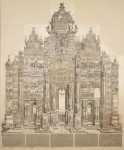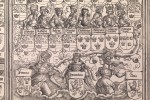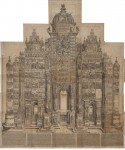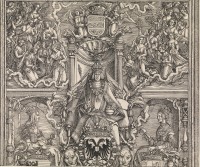 The Arch of Honour of Maximilian I was created in 1515 by master printmaker Albrecht Dürer. It was one of three monumental works inspired by Roman imperial triumphs commissioned by the emperor to emphasize his family’s illustrious lineage, his political and military victories, his piety, strength and overall greatness. Two of them, the Arch and the Great Triumphal Chariot were designed by Dürer. For the Arch of Honour of Maximilian I alone, his workshop carved a total of 195 wood blocks, 171 of which survive at the Albertina in Vienna, which were printed on 36 large sheets of paper. (Dürer didn’t do any of the carving or printing himself. He did the drawing; Hieronymus Andreae of Nuremberg was Dürer’s blockcutter.) When placed together as a single artwork, the Arch is a massive 9′ 10″ by 11′ 6″. It’s the largest woodcut created in the Renaissance and one of the largest in the world.
The Arch of Honour of Maximilian I was created in 1515 by master printmaker Albrecht Dürer. It was one of three monumental works inspired by Roman imperial triumphs commissioned by the emperor to emphasize his family’s illustrious lineage, his political and military victories, his piety, strength and overall greatness. Two of them, the Arch and the Great Triumphal Chariot were designed by Dürer. For the Arch of Honour of Maximilian I alone, his workshop carved a total of 195 wood blocks, 171 of which survive at the Albertina in Vienna, which were printed on 36 large sheets of paper. (Dürer didn’t do any of the carving or printing himself. He did the drawing; Hieronymus Andreae of Nuremberg was Dürer’s blockcutter.) When placed together as a single artwork, the Arch is a massive 9′ 10″ by 11′ 6″. It’s the largest woodcut created in the Renaissance and one of the largest in the world.
 Denmark’s Royal Collection of Graphic Art has two complete sets of the Arch of Honour of Maximilian I prints. They were both stored in loose leaf form initially, until the 1860s when folklorist and art historian Just Matthias Thiele, director of the Royal Collection, had one of the two glued onto canvas so the masterpiece could be display in one huge billboard-sized artwork the way Dürer and the emperor had intended for it to be seen as part of what art historian Hyatt Mayor has called “Maximilian’s program of paper grandeur.” The canvas version was on display in the Prinsens Palæ (the Prince’s Mansion) in Copenhagen, then home to the Royal Collection of Graphic Art, and remained on display there when the Prinsens Palæ became the official home of the National Museum of Denmark in 1892.
Denmark’s Royal Collection of Graphic Art has two complete sets of the Arch of Honour of Maximilian I prints. They were both stored in loose leaf form initially, until the 1860s when folklorist and art historian Just Matthias Thiele, director of the Royal Collection, had one of the two glued onto canvas so the masterpiece could be display in one huge billboard-sized artwork the way Dürer and the emperor had intended for it to be seen as part of what art historian Hyatt Mayor has called “Maximilian’s program of paper grandeur.” The canvas version was on display in the Prinsens Palæ (the Prince’s Mansion) in Copenhagen, then home to the Royal Collection of Graphic Art, and remained on display there when the Prinsens Palæ became the official home of the National Museum of Denmark in 1892.
 After decades exposed to direct sunlight and unstable climactic conditions, the paper had discolored, darkened and deteriorated to the point where curators decided it was no longer fit for public display. It was taken down and placed in storage. The Royal Collection of Graphic Art, now a department of the National Gallery of Denmark’s Statens Museum for Kunst (SMK), last year set SMK conservators to the arduous task of restoring the Arch in time for a major exhibition this spring.
After decades exposed to direct sunlight and unstable climactic conditions, the paper had discolored, darkened and deteriorated to the point where curators decided it was no longer fit for public display. It was taken down and placed in storage. The Royal Collection of Graphic Art, now a department of the National Gallery of Denmark’s Statens Museum for Kunst (SMK), last year set SMK conservators to the arduous task of restoring the Arch in time for a major exhibition this spring.
 Conservators analyzed the paper (flax and hemp fibers which means it was made of pulped clothes) and adhesives (boiled wheat paste, likely used in the mounting of the paper on the canvas, and animal skin glue likely used in the 16th century during the paper production process), examined the surface using raking light photography to reveal extensive damage to the paper (they found folds, tears, bulges, cracks) and ink. Transmitted-light photography found a watermark on the paper: a dual-headed eagle wearing the imperial crown, the Holy Roman Emperor’s coat of arms, which underscores how personally connected Maximilian I was to the project.
Conservators analyzed the paper (flax and hemp fibers which means it was made of pulped clothes) and adhesives (boiled wheat paste, likely used in the mounting of the paper on the canvas, and animal skin glue likely used in the 16th century during the paper production process), examined the surface using raking light photography to reveal extensive damage to the paper (they found folds, tears, bulges, cracks) and ink. Transmitted-light photography found a watermark on the paper: a dual-headed eagle wearing the imperial crown, the Holy Roman Emperor’s coat of arms, which underscores how personally connected Maximilian I was to the project.
 Once the analysis and documentation were done, the SMK conservators worked assiduously to clean the yellowed surface and stabilize the leaves. They used enzymes specifically targeted to break down the wheat paste adhesive without harming the original paper glue. Once the pages were removed from the canvas backing, conservators mended the myriad tears and folds that had developed over the centuries. They did this in public in an exhibition called Dürer under the Knife! which ran from September to December 2014 so visitors to the SMK could observe the marvels of conservation science in action on a massive piece of equally massive artistic and historical significance.
Once the analysis and documentation were done, the SMK conservators worked assiduously to clean the yellowed surface and stabilize the leaves. They used enzymes specifically targeted to break down the wheat paste adhesive without harming the original paper glue. Once the pages were removed from the canvas backing, conservators mended the myriad tears and folds that had developed over the centuries. They did this in public in an exhibition called Dürer under the Knife! which ran from September to December 2014 so visitors to the SMK could observe the marvels of conservation science in action on a massive piece of equally massive artistic and historical significance.
 The restored Arch of Honour of Maximilian I is now on display at the Might and Glory: Dürer in the Emperor’s Service exhibition which runs from March 5th through June 21st of this year. If you can’t make it to Copenhagen by then, you can explore the cleaned and restored Arch in this huge zoomable image on the SMK website. There are a few annotations explaining the complex imagery, enough to make you wish there were about a thousand more of them. Also, it’s not as large or as sharp as the new one, but in case you, like me, can never get enough before-and-after pictures, here’s a zoomable image of the print before it was cleaned. It looks like it was soaked in black tea compared to the clean version.
The restored Arch of Honour of Maximilian I is now on display at the Might and Glory: Dürer in the Emperor’s Service exhibition which runs from March 5th through June 21st of this year. If you can’t make it to Copenhagen by then, you can explore the cleaned and restored Arch in this huge zoomable image on the SMK website. There are a few annotations explaining the complex imagery, enough to make you wish there were about a thousand more of them. Also, it’s not as large or as sharp as the new one, but in case you, like me, can never get enough before-and-after pictures, here’s a zoomable image of the print before it was cleaned. It looks like it was soaked in black tea compared to the clean version.